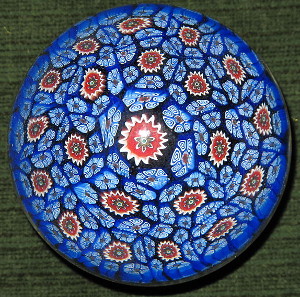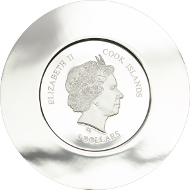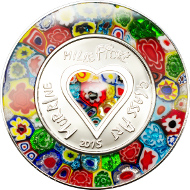May 28, 2015 – When historian Marcantonio Sabellico first laid eyes on glassworks produced with the millefiori technique around 1500, they seemed to him like a flower meadow. The technique thus derives its name from the Italian expression for 1000 flowers – “mille fiori”.
This glasswork technique dates back a long time. Already the Egyptians were familiar with it around 1800 BC, and glassmakers in the 4th and 3rd century BC commonly used the “thousand flowers glass” to make bowls. In the form of Islamic glass art, the technique found its way into the Early Modern Period and became a widely exported product of the Murano islands north of Venice in the late 15th century.
Paper weight made of Millefiori glass. Source: Wikipedia.
But the triumph of the millefiori glass in northern Europe really began with an 1845 trade show in Vienna on which the glassmakers from Murano and Venice exhibited their manufacture. From then on, glass foundries outside of Italy also started to produce vessels and decorative objects in this style.
Millefiori glass is made from so-called murrine, thin slices of glass rods, which are in turn composed of several multi-coloured glass strands melted into one single rod. The cross-sections of these glass rods look like flowers, or flower petals. Cast into forms or enclosed in glass bubbles, the vessels, paper weights, decorative objects, and pieces of jewellery formed from this material indeed look as if made of a thousand flowers.
Cook Islands / 2015 / 5 Dollars / Silver .999 / 20 g / 65 mm / Proof / 999 pieces.
Coin Invest Trust continues a longstanding tradition by discovering the millefiori technique for numismatics. Its innovative Murrine Millefiori Glass Art coin derives its extraordinary effect from the contrast of brilliantly coloured glass and monochrome silver surface. A small heart of millefiori glass forms the luminous centre of the new coin and renders every specimen unique.
The coins are minted by B.H. Mayer’s Kunstprägeanstalt GmbH. Collectors can purchase the issue through specialty dealers.
For more information on this coin or other coins designed by CIT please visit the website of Coin Invest Trust.
This video shows how Millefiori glass is made.






